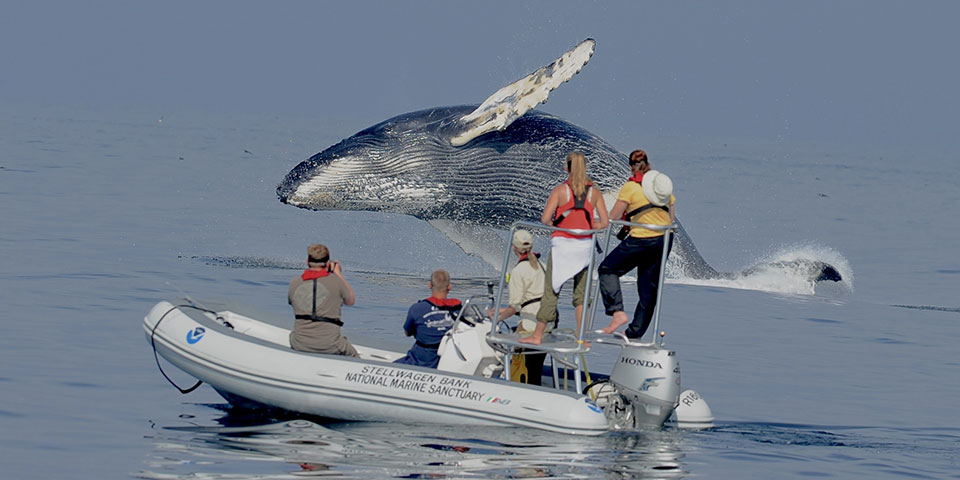Noise
Stellwagen Bank

Why is it a concern?
The level of noise pollution in the oceans and in the Stellwagen Bank National Marine Sanctuary (SBNMS) has increased dramatically during the last 50 years. Noise generated by human activities can have a detrimental effect on marine life. Studies have documented behavioral responses, lost listening opportunities, and physical injuries in wildlife due to exposure to anthropogenic (human-induced) noise. Sources of underwater noise include large commercial shipping traffic such as container ships, freighters, barges and tankers; smaller recreational and commercial vessels; sonars used in military training; pile drivers and dredging used in marine construction; airguns and other seismic sources used in energy exploration; sonars and other active acoustic sources used in research activities; and aerial sources such as overflights.
Effects from high decibel noise, especially at close range, can cause acute physiological effects in living marine resources, such as tissue damage in lungs and ears and ruptured or hemorrhaged body parts, Other effects include masking of important signals (such as those used for echolocation, inter-species communication, and predator-prey cues), behavioral alterations (such as changes in migration patterns or abandonment of important habitats), and adverse effects to animal energy and physiology. Additionally, fish and invertebrates may experience damage to eggs, reduced reproduction rates, and physiological or morphological damage. Noise may also cause marine mammals and other organisms to acquire temporary or permanent hearing loss. The disorientation and hearing loss may account for cases in which ships collide with marine mammals that are apparently unaware of the approaching vessel. Most strikes occur in coastal waters on the continental shelf where large marine mammals concentrate to feed.
Overview of Research
| Project Name | PI and contacts | Links |
|---|---|---|
NOAA Noise Reference Station Network (NRS) |
||
Ambient Noise |
http://stellwagen.noaa.gov/science/passive_acoustics_ambient.html |
|
Soniferous Fish |
http://stellwagen.noaa.gov/science/passive_acoustics_son.html |
|
Noise Budgets |
http://stellwagen.noaa.gov/science/passive_acoustics_noise.html |
|
Noise Mapping |
http://stellwagen.noaa.gov/science/passive_acoustics_current.html |
Soundscape Monitoring Program, NOAA
This soundscape monitoring program takes place at Stellwagen Bank, Gray's Reef, Florida Keys, and Flower Garden Banks national marine sanctuaries. Shallow water hydrophones are deployed and the data collected from them will ultimately be used to classify the acoustic signatures of the sites, including relative contributions of human-produced noise, as well as marine wildlife (invertebrates, fish and mammals) and geophysical sources (wind, waves).
Science Needs and Questions
- What are the relative inputs of sound from various sources to the sanctuary’s total “ocean noise budgets,” and how do they vary at temporal and spatial scales?
- What are the temporal/spatial distributions of vocalizing marine animals in the sanctuary?
- Are changes in the behaviors of vocally-active marine animals relative to anthropogenic sound sources biologically significant, and how can this information inform underwater noise policy for the sanctuary?
Education and Outreach Material
Podcast on Noise and Soundscapes in SBNMS with Dr. Leila Hatch
Additional resources including soundclip examples and lesson plans.
Discovery of Sound in the Sea offers many resources related to the issue of noise in the ocean.
References
Clark, C.W., W.T. Ellison, B.L. Southall, L.T. Hatch, S.M. Van Parijs, A. Frankel & D. Ponirakis. 2009. Acoustic Masking in Marine Ecosystems: Intuitions, Analysis, and Implications. Marine Ecology Progress Series 395:201-222
Hatch, L.T., Clark, C.W., Merrick, R., Van Parijs, S., Ponirakis, D., Schwehr, K., Thompson, M. & Wiley, D. (2008). Characterizing the relative contributions of large vessels to total ocean noise fields: a case study using the Gerry E. Studds Stellwagen Bank National Marine Sanctuary. Environmental Management.
Hatch, L.T. & K.M. Fristrup. 2009. No barrier at the boundaries: implementing regional frameworks for noise management in protected natural areas. Marine Ecology Progress Series. 395:223-244
Hatch, L. T., C. W. Clark, R. Merrick, S. M. Van Parijs, D. Ponirakis, K. Schwehr, M. Thompson, and D. Wiley. 2009. Erratum to: characterizing the relative contributions of large vessels to total ocean noise fields: a case study using the Gerry E. Studds Stellwagen Bank National Marine Sanctuary. Environmental Management 44:998-999. National Research Council. 2003. Ocean Noise and Marine Mammals. The National Academies Press. Washington, DC.
Richardson, W.J., C.R. Greene, C.I. Malme, and D.H. Thomson. 1995. Marine Mammals and Noise. Academic Press. New York, NY.
Van Parijs, S.M., C.W. Clark, R.S. Sousa-Lima, S.E. Parks, S. Rankin, D. Risch & I.C. Van Opzeeland. 2009. Mesoscale applications of near real-time and archival passive acoustic arrays. Marine Ecology Progress Series 395: 21-36
Scheifele, P.M. and M. Darre (2005). Noise levels and sources in the Stellwagen Bank National Marine Sanctuary and the St. Lawrence River Estuary. Marine Conservation Series MSD-05-1. U.S. Department of Commerce, National Oceanic and Atmospheric Administration, Marine Sanctuaries Division, Silver Spring, MD. 26pp.

